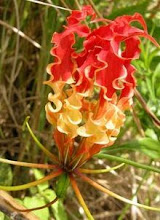Lily Ho's post of a climber/vine with lovely clusters of pinkish small flowers and heart-shape leaf brought back memories of plants in my old house in Borneo. Near the entrance, clinging on the shared fence with my neighbour thrived the same plant species. This sun loving vine - coral vine or Antigonon leptopus plant was hardy and had survived numerous attempts to uproot and destroyed it - it kept bouncing back. I had to admit they were quite pretty at time ( reaching out from the fence) attracting bees and insects but the dried shriveled leaves between 'double' fences were an eye-sore and hard to get to. I thought it was a nuisance weed so to get rid of the dried leaves i ever set fire on it and watched the flames leaping high, like a fast-fuse of a dynamiteh and nearly burn-down my neighbour precious rambutan tree. Luckily the flame extinguished itself without leaving too much evidence of my mis-calculation. One fine afernoon i decided to 'trace' origin of the vine and had to dug more than 1 foot deep to reveal the bulbous hard tuber not knowing that the tuber is edible. After tending to the bed of sweet-potatoes, i built a fire and remembered roasting this unique tuber on the shallow pit - at least it smell pleasant.
Nearby sharing the same fence and on the other fences as well were another climber, gloriosa superba or flame lily - the leaf tips ended with tendrils and the unique spider-like crimson /yellow petals were pretty eye- catching. IDing this marvelous plant from botany book was not difficult. This was perhaps one of the few flowers that i plucked and examined in details under my dad's magnifyng glass at the seeds attachment of sectioned fruit segments. Well this plant had succulent but posionous tuber in fact all parts of this plant are poisonous if ingested. The smeshed tuber had a whiteish juice and sharp 'bitter green' smell. The other closely inspected flowers include the trumpet-shaped morning glory the commonest fence crawler. In fact the other perimeters of the house were dominated by this 'weed'.
The other climber was 'winter-melon' or Tung Qua. The stems were covered with prickly stiff hairs and 'hollow' like a straw inside. Leaves were broad and equally hairy. If you slice off the stems you can literally observe water oozes out of the wound. Under the tender care of my dad, they grew fast, covering the entire frontal fences in no time. My dad also taught me how to do artificial cross-pollination by rubbing the pollens from a male flower to the female stigma. ( I saw him applying the same procedure to the papaya tree) Following a successful pollination, the yellow female flower dropped off leaving a growing fruit. Melons can grow to huge size and the skin was light green with whitish powder. A single climber can yield up to 10-20 melons each weighing >20 kg(?). I remembered we gave to our neighbours and sold off the excess even thought it did not fetch any good price. Our fence was permanently deformed or sagged as a result of the weight of tens-twenties melons.
Thursday, January 11, 2007
Subscribe to:
Post Comments (Atom)

No comments:
Post a Comment